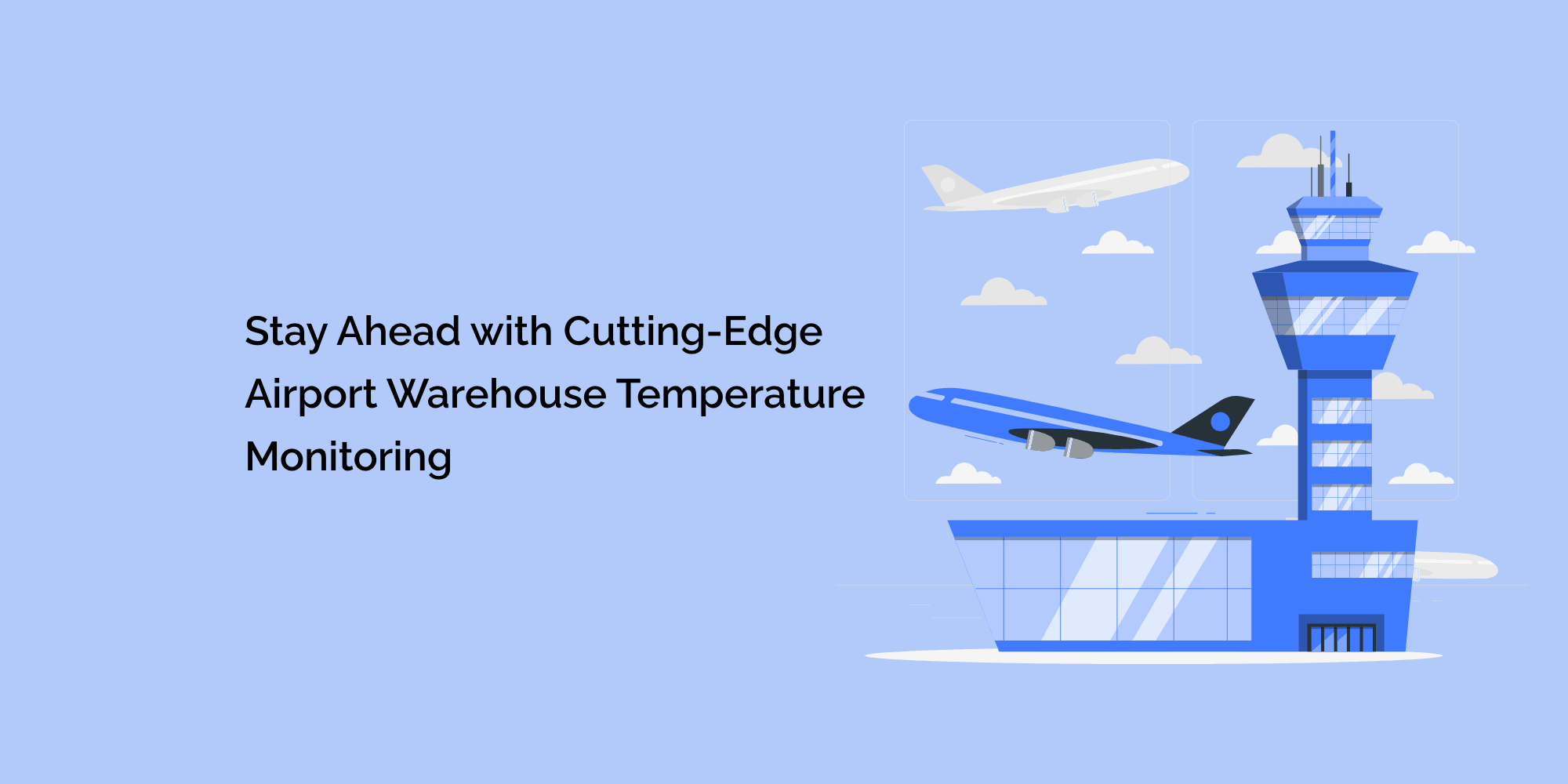Airport warehouses serve as critical hubs in the global supply chain, facilitating the storage and movement of goods. Within these warehouses, maintaining optimal temperature conditions is paramount to preserve the quality and integrity of various cargo, including perishable goods, pharmaceuticals, and sensitive materials.
To stay ahead in the competitive logistics industry, airport warehouses need cutting-edge temperature monitoring solutions that provide real-time data, advanced analytics, and remote accessibility.
In this blog, we will explore the importance of staying ahead with cutting-edge airport warehouse temperature monitoring and discuss the innovative technologies and practices that can revolutionize temperature control.
The Significance of Temperature Monitoring in Airport Warehouses:
Understanding the Impact of Temperature Deviations: Temperature deviations can have severe consequences on different types of cargo. Perishable goods can spoil, pharmaceuticals can lose their efficacy, and sensitive materials can become compromised. It is crucial to recognize the potential risks and financial implications of inadequate temperature monitoring, such as product loss, customer dissatisfaction, regulatory penalties, and damage to brand reputation. By prioritizing temperature monitoring, airport warehouses can ensure cargo safety, reduce losses, and maintain compliance with industry standards.
Embracing Cutting-Edge Temperature Monitoring Solutions:
Real-Time Monitoring for Immediate Intervention: Cutting-edge temperature monitoring solutions offer real-time data collection, enabling immediate intervention in case of temperature deviations. Wireless sensors strategically placed within the warehouse environment continuously monitor temperature conditions and transmit data to a centralized system. This real-time monitoring capability allows warehouse personnel to take prompt action to mitigate risks and maintain cargo safety.
Remote Accessibility for Effective Management:
With the advancement of technology, remote accessibility has become a crucial feature in temperature monitoring systems. Cloud-based platforms and mobile applications provide warehouse operators with remote access to real-time temperature data and system controls. This remote accessibility empowers operators to monitor temperature conditions, receive alerts, and make informed decisions even when they are off-site, enhancing operational efficiency and ensuring proactive management.
Advanced Analytics for Data-Driven Decision Making:
Cutting-edge temperature monitoring solutions employ advanced analytics to transform temperature data into actionable insights. By leveraging machine learning algorithms and data visualization tools, warehouse operators can identify temperature patterns, predict potential issues, and optimize temperature control strategies. Advanced analytics enable data-driven decision making, helping warehouses stay ahead of temperature-related challenges.
Integration with Internet of Things (IoT) Ecosystems:
The integration of temperature monitoring systems with broader IoT ecosystems presents immense opportunities for airport warehouses. By connecting temperature sensors, data platforms, and other smart devices, warehouses can achieve comprehensive control and monitoring. IoT integration enables automated workflows, seamless data exchange, and predictive maintenance, revolutionizing temperature monitoring and overall warehouse operations.
Innovative Technologies for Enhanced Temperature Monitoring:
Wireless Sensor Networks for Comprehensive Coverage:
Cutting-edge temperature monitoring solutions utilize wireless sensor networks to provide comprehensive coverage within the warehouse environment. These networks consist of interconnected sensors strategically placed in key areas, ensuring accurate and continuous temperature monitoring. Wireless sensor networks offer flexibility, scalability, and ease of installation, making them an ideal choice for airport warehouses.
Edge Computing for Real-Time Processing:
Edge computing brings data processing closer to the source, reducing latency and enabling real-time analytics. By processing temperature data at the edge, warehouse operators can quickly detect and respond to temperature deviations without relying solely on cloud-based platforms. Edge computing enhances the responsiveness and efficiency of temperature monitoring systems, particularly in large-scale warehouse environments.
Blockchain Technology for Enhanced Security and Traceability:
Blockchain technology provides a secure and immutable framework for temperature data storage and traceability. By utilizing blockchain, temperature monitoring systems can ensure the integrity and transparency of temperature records throughout the supply chain. Blockchain-based solutions enhance data security, eliminate the risk of tampering, and provide a trustworthy audit trail for regulatory compliance.
Artificial Intelligence (AI) and Machine Learning (ML) for Predictive Capabilities:
AI and ML technologies empower temperature monitoring systems with predictive capabilities. By analyzing historical temperature data, machine learning algorithms can identify patterns, anomalies, and potential temperature deviations. This predictive capability allows warehouse operators to proactively address temperature-related risks, reduce downtime, and optimize operational efficiency.
Best Practices for Implementing Cutting-Edge Temperature Monitoring:
Performing a Comprehensive Warehouse Assessment: Before implementing cutting-edge temperature monitoring solutions, it is crucial to conduct a comprehensive warehouse assessment. This assessment involves evaluating warehouse layout, identifying critical control points, and determining the ideal sensor placement. Understanding the unique requirements and challenges of the warehouse environment ensures the effective deployment of temperature monitoring systems.
Choosing the Right Technology and Solution:
Selecting the most suitable temperature monitoring technology and solution requires careful consideration. Factors such as warehouse size, cargo types, connectivity options, data management capabilities, and scalability should be evaluated. Warehouse operators should collaborate with temperature monitoring experts and technology providers to identify the optimal solution that aligns with their specific needs and goals.
Ensuring Proper Installation and Calibration:
Proper installation and calibration of temperature sensors, probes, and monitoring equipment are essential for accurate and reliable temperature measurements. Warehouse operators should follow manufacturer guidelines and industry best practices to ensure optimal performance and maintain calibration standards. Regular calibration checks should be conducted to validate temperature accuracy.
Establishing Standard Operating Procedures and Training:
Establishing standard operating procedures (SOPs) is crucial for ensuring consistent temperature monitoring practices. SOPs outline the responsibilities of warehouse personnel, including temperature data collection, response to temperature alarms, and compliance with regulatory guidelines. Regular training sessions should be conducted to educate staff on the use of temperature monitoring systems and adherence to SOPs.
Conclusion:
In the fast-paced world of logistics, staying ahead with cutting-edge airport warehouse temperature monitoring is imperative to ensure cargo safety, comply with regulatory standards, and maintain a competitive edge. By embracing real-time monitoring, remote accessibility, advanced analytics, and integration with IoT ecosystems, airport warehouses can optimize temperature control, enhance operational efficiency, and mitigate risks.
Innovative technologies such as wireless sensor networks, edge computing, blockchain, and AI/ML provide unprecedented capabilities for accurate temperature monitoring and predictive intervention. By following best practices, implementing the right technology, and fostering a culture of continuous improvement, airport warehouses can stay ahead and deliver exceptional cargo safety








